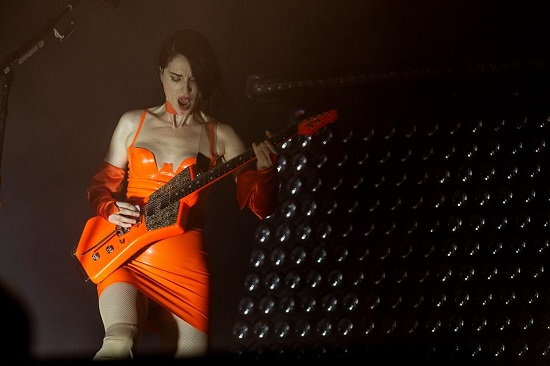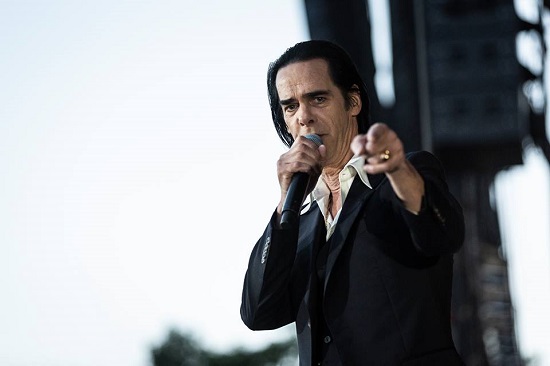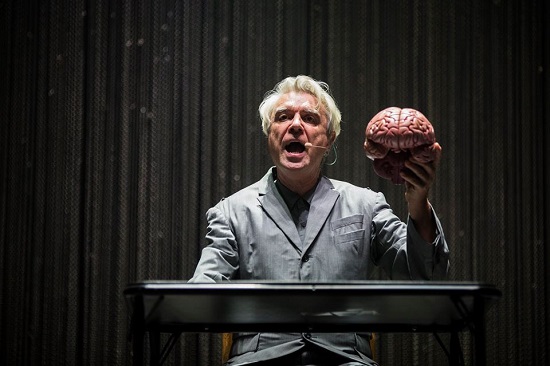David Byrne at Roskilde, photo by Christian Hjorth
A bacchanalian party has already been raging for four days by the time we arrive on the Wednesday of Roskilde’s week-long behemoth. The settlements on the outskirts of the festival site have been transformed by the heatwave into an Mad Max dust bowl. Shabby, dirty and graffitied tents nestle among enormous home-brought sound systems that clash under the baking sun. In the so-called ‘Dream City’, there are huge, fan-made structures that have been in the works for months as part of the traditional competition for the best-themed campsite: ‘A Camp of Ice and Fire’ boasts its own dragon, ‘Camp Nam’ its own Apocalypse Now hut, and ‘Camp Zoo’ its own marauding gang of intoxicated Danes dressed as their favourite animals. Here, audience-instigated raves power on without pause for the duration of the festival’s run.
Those who wish to pass through the perimeter gates (we’re reliably informed that not all of these revellers bother with the actual gigs), are greeted with six stages that cater to every facet of what a great modern festival should provide. It’s telling that the two opening acts to choose from are Newcastle doom crew Pigs Pigs Pigs Pigs Pigs Pigs Pigs (whose frontman’s “pale and stupid British appearance” was quite hilariously noted in the Danish press), and the brilliant Bugandan clash of relentless drums and electronics that is Nihiloxica. A surprising amount of the line-up of this ostensibly mainstream festival is, as a friend of mine puts it, “well Quietus”.
Yasuaki Shimizu, for example, is the pioneering Japanese jazz titan whose midday set on Friday is our first taste of the Gloria stage, a repurposed warehouse and the most distinctive of Roskilde’s stages. It is pitch black in here save for jagged, cut-up projections of Shimizu. His set is stunning: each of his pieces is gorgeous and each for a different reason. Sometimes Shimizu, armed for the most part with a glistening tenor sax aside a young producer on laptop and synth who loops the former’s lines, begins with fragmented and disparate melodies that maze in among each other to gradually unveil a glorious and transcendent whole. Elsewhere, as on ‘Semi Tori No Hi’ from his 1982 masterpiece Kakashi, he lays down a low sweep of electric clarinet that gradually builds into a glorious, swarming force of beautiful darkness. Sometimes he simply lets loose with sheer musicianship, his saxophone squealing and wailing forever upwards, but somehow with the delicacy and poise of Vaughan Williams’ ‘Lark Ascending’. The set’s depth is undercut by a glint of humour – a bizarre instrument that seems to be a mixture of clock radio and drone control pad is evidently funny to him too as he extends its comically massive aerial – and the whole thing is a gem of experimental brilliance nestled among a festival slathered in mainstream names.
St Vincent’s show, early on the first evening, is the first that really exhibits just why the festival’s approach to its live curation is so faultless. There are so many good bands at Roskilde that it’s easy to miss the fact that the line-up is quite sparse, with value placed on the quality of bookings, lengthy soundchecks and longer sets. St Vincent’s set is one of only three at the enormous Arena tent that day, and her hour-long show exhibits everything that makes Annie Clark such a supreme live force. The four-piece are stood side-by-side like Kraftwerk, the rhythm section masked with Clark appropriately robotic and garbed in red and black as she and synth genius Toko Yasuda lay down lick after lick of wicked, powerful pop. It brims with charisma – more than just a festival show, it is an hour-long immersion.

St. Vincent
Late that night, Nine Inch Nails are at the Arena stage. There’s a booming sound system, with Reznor bathed in smoke and backed with thunderous strobe flashes as NIN rattle through their most surging material. They refuse to let up, playing into the early hours with only split-second pauses between each track. It is breathless, ferocious and intense, as they cram in as many rushes of industrial power as they can. Only ‘Hurt’, their encore, that offers any release.
Shortly beforehand, it falls to Eminem to provide the inaugural taste of the site’s famous Orange stage, a colossal canopy first purchased from The Rolling Stones in 1978. He’s an artist it’s hard not to feel a little indifferent about in 2018, especially after the misfire of last year’s Revival LP, the latest in a string of highly mediocre albums. It might just be the fact that the Orange Stage boasts a mystifyingly loud sound system for an outdoor stage of its size, but live, Eminem far surpasses our (admittedly low) expectations. Once you accept that what’s underpinning the set is mainly a sense of the cartoonish and preposterous, it’s not hard to get swept away with it. Hype man Mr Porter and Eminem spar childishly and with an embrace of cliché – there’s even the ‘whose side of the crowd is louder’ cheer-off – and 130,000 of us are swept away for the ride. Furthermore, a late medley of ‘Without Me’, ‘My Name Is’ and ‘The Real Slim Shady’ prove that Marshall Mathers still has more than just energy up his sleeve.
Throughout the weekend, the Orange stage is a joyful riposte to the idea that a massive outdoor rig can’t possibly provide a proper atmosphere. Memories of inaudible Hyde Park shows and limp headline shows at festivals across Europe tend to linger, but Roskilde’s colossal central arena is always delightfully deafening. Interpol’s mid-afternoon set finds their signature licks of pumping bass made even more rollicking, while Massive Attack’s set in the early hours of the morning is a tidal wave of darkness. There are some mediocre sets there – Dua Lipa and Bruno Mars fail to convert those of a “well Quietus” disposition – but at least they’re loud.
No one can inhabit the Orange stage with quite as much devilish panache as Nick Cave and the Bad Seeds. Last year I reviewed his arena tourand was staggered by just how he could twist the most soulless of mega-venues to his own devices. Skeleton Tree was an intimate and crushing LP, and its tour was overwhelming. When treated to a stage like this, it is even more so. Cave peppers the set more heavily with older material, ‘Loverman’ sears with rage and ‘Stagger Lee’ turns the crowd into a baying, beastly mob as Cave slithers and hisses among them. Again, though, it is material from Skeleton Tree and Push The Sky Away that is the most remarkably gorgeous. Second time around, it’s still spectacularly moving to see a show so tender on a stage so huge.
Roskilde is more than main stage spectaculars, however; on its outskirts there is a cavalcade of leftfield delights. El Leopardo spin joyous Colombian techno well into the night on the distant Apollo stage. On the small stages of Avalon and The Pavilion, there is John Maus, Ben Frost, Watain, Charlotte Gainsbourg and Richard Dawson – Dawson more stunning than ever as he bombards an unfamiliar crowd with a brutal draught of ‘The Vile Stuff’. At Apollo, Kali Uchis begins the final day with a glistening set under a blazing sun that cements her as 2018’s best pop newcomer.

It is the Arena stage, however, that remains Roskilde’s pinnacle. I can’t remember a great deal about My Bloody Valentine’s show that lasted til 3:30am other than an intoxicated man briefly strangling me in a misjudged neck-height hug, but I’m sure it was excellent. Sandwiched between Nick Cave and Massive Attack is David Byrne, who performs in beautiful synchronisation among a weaving throng of musicians, carrying their instruments as they slink and sway around a stage draped in silver. There is something so utterly joyous about the way they move, Byrne their beating heart as they gleefully race through the choicest cuts from his decades-long career as an outlier. Hearing ‘This Must Be The Place’ and ‘Burning Down The House’ played with such freshness, power and joy is among the most supremely happy experiences it’s possible to have.
Not long before the festival, Byrne’s current tour show was described by tQ’s William Doyle as the best gig he’d ever seen. Ever. Were it not for Stormzy’s midnight Arena show on the second night at Roskilde, I’d be inclined to agree.Footage of Stormzy’s first set at Roskilde two years ago has become one of the defining documents of the great Londoner’s rise to superstardom, and as DJ TiiNY spins Lethal Bizzle and Skepta for a manic moshpit in the build-up to his arrival, it’s clear that the sequel is going to be something to savour. “Roskilde feels like my second home – that show made the world see me as a performer,” says Stormzy when he bounds his way onstage and the lights shift from blue to a deep red. “We need to create some kind of history tonight.”
There follows a performance of righteous intensity. Free of bells and whistles, it rests on Stormzy’s charisma alone. And he has a gigaton of charisma, maybe more. He’s clearly moved by the sheer scale of the crowd, but never overcome, seizing every opportunity to shout out his 20,000 strong “energy crew” as he ups his game to what must surely be its highest level. Beats shudder through the massive tent and moshpits begin to pock the crowd as Stormzy struts magnetically in front of us. “We’re gonna call this Roskilde part two,” he proclaims above a roaring throng, drenched in sweat. “I’ll be back, next time.”


